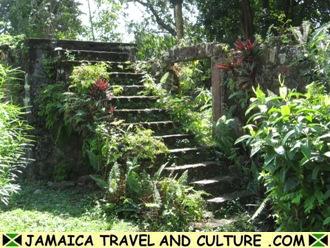| Works of Annie Fields |
by
Annie Fields
1896
Part 3 -- January 24 - 30
Haiti
Jamaica
^Friday^ Sunday ^Saturday 25 24th
found us at Cape Nicholas Mole, on the Island of Haiti* ^we ran
down here Friday night it was a road stead back in
harbor. The shores were covered with the ruins of
fortifications built by the French* garlanded with the lovely
tropical growths of this region. Pelicans* were fishing
all about the cliffs. And The Captain shot one and
brought it ashore. I had no idea before of the size or
beauty of these dove colored creatures -- Seven feet I believe
this one measured from tip to tip; and it was pleasure
enough to lie the long afternoon watching them fish in the clear
lovely water. In the night again we steamed away for Port
au Prince, Haiti.* Here we passed Saturday morning -- a
more strangely barbarian place probably does not exist on the
face of the earth! Strangely barbarian -- because it is
not exactly the wild and native barbarian ^one sees
just^ as he may be found in the wilds of Africa, but after years
of occupation by Spanish, English and
Page 43*
I have entirely omitted in this brief account of Inagua to
describe our drive. We started in the carriage at about
eleven o'clock to visit the old disused salt works.* After
driving in the hot sun a long distance we came upon level
stretches of salt marsh ^sand separated by low dikes^
where the water had been shut in and left to evaporate in the
scorching heat. The whole scheme was a failure, but the
wild wide stretches of beach ^sand^ and marsh
^shallow water^ were very sad and impressive. As we gazed
far out over these dazzling sands we saw a cloud of ^rose red^ pink
flamingoes, ^looking^ probably as tall as men
standing still ^in long rows^ reflected like pink sunset clouds
in the wet surface beneath.* The scene has left an
ineffaceable memory. The intolerable heat, the wild shore,
the endless sands and these birds, glowing, innumerable
untameable, -- have furnished a new chamber of memory for the
imagination to wander in.
Page 44 [Resumes the narrative from p. 42]
French* -- here it is ^the place^* at last abandoned to
the colored people who have multiplied like the ant, and without
government or schools or churches to influence them outside
of themselves they ^continue to^ multiply with the
fertility of unchecked animal creation, while drink and unthrift
coupled with their love of music and color and the shows of
things produces a [deleted letter] condition of
things happily not to be seen elsewhere -- They
tried to get certain dues from the Captain but were
unsuccessful, while Mr. Pierce invited a Mr. Keitel of the
banking house,* a German who seemed an intelligent man to dine
with us. Mr. Keitel accepted, we made ready -- the table
prettily garnished and all of us dressed -- but no Keitel
appeared -- and no excuse. The whole thing's seemed
in keeping -- therefore as soon as dinner was over and we had
passed a lovely hour on the captain's deck in the moonlight and
soft air, we steamed away from Haiti towards Jamaica. The
sea was smooth all night because we were embayed and it was a
half formed scheme to rest over Sunday (27th) off the Cape Dame
Marie* but the Captain saw no reason for such delay
Therefore we kept on across the open sea to Jamaica. All
day Sunday
Page 45
the good ship kept steadily on, but some of us were very
sea-sick. It was warm, and blowing, and rainy, -- towards
night -- but there was no pleasure for some of us while
^the ship^ we rolled. The sea between the islands
seems to be forever rolling heavily; a bad kind of rolling too for
those
who
are
not very steady at sea. However before bed time we
came into the safe and pretty harbor of Port Antonio.* A
call was given for a pilot because the Captain had never been
here before but he was scarcely needed -- the light-house with
its rays of two colors and the secure harbor, deep enough to
allow us to anchor at the wharf on Monday morning, were
beautiful to look upon.
The rain of yesterday washed the air as well as the streets and a cool breeze was blowing as we drove along the shore before noon. Here at last were the tropics indeed. We kept close to the sea, but as we drove through the little town, which is really much larger than one would suppose looking at it from the ship -- we found well paved streets white and clean with no sidewalks and little shops like booths open, chiefly towards the street. There are comparatively no white people, a small society of a dozen families, but there are colored men & women of every nationality
Page 46
It is a strange contrast to the African race that of the Coolies!* The East Indian has been found the better workman{;} therefore he is invited to come here, with his family, on certain wages indentured for five years, at the end of this time he is allowed to return and his passage paid, or he may remain under certain conditions. Seventy five per cent return to their native land when the time is up; but it is interesting to consider what effect the remainder will eventually have ^upon this land^. They wear a noble resolved self-respecting air, and one passes them in the road with a new sense of importance. Few things have impressed me more than the aspect of these men. With the opportunity which will by and by ^be^ theirs in a land which is pretty sure to be an independent republic, I fancy before many years; with the increase of shipping, bringing opportunity ^also^ for education nearer we are likely to see -- I should say -- the world may see -- not ourselves -- a strong noble race, with the African people -- as their servants and allies. They seem to have in them the spirit of dominance, they certainly have the power of self control and the result may be foreseen if not experienced by us.
Page 47
The Africans do not fraternize with them; indeed they are said
to be inimical but there is no outward expression of ill-feeling
except [that written over their ?] living ^they
prefer
to
live^ apart. How indeed can they live together with such
varying [deleted word] ^views^ of religion and life
if the African can be said to possess any independent views save
those he has borrowed or inherited from his white masters.
Port au Prince discouraged one from believing in any reserved
self-motive power in the race so far as he has one. It is
however too early to be definite upon this subject. Toussaint
L'Ouverture* seems to have possessed original power, but he
stands almost "a sport" among the black races as we know
them.
How sunny and yet cool was our morning drive! The sun
itself was excessively hot, but the ^we^ were sheltered
and the breeze was delicious. We saw the Bread-fruit Tree
in its perfect beauty also the Mango with its bronze-lined
leaves and a fine sort of water-laurel or rhododendron which we
did not know, and flowers flowers everywhere.* O how
beautiful it was. A white heron rose near the shore as we
drove and a native was wading in the crystal water regardless of
the sun upon his head, which would probably have slain us.
The brilliant red of the Hisbiscus [Hibiscus ?] and the
Pointsettia [deleted word] ^among^ their dark leaves was
always a pleasure to make us cry out, much to the amusement
of
Page 48
our colored driver who was a serious faced intelligent boy who
know [intended knows or knew ?] the
names of a good many plants and could answer some of the
questions we put to him. We returned to the beautiful
Hermione to luncheon, laden with roses and "false hops" a lovely
shrub, ^with^ spotted leaves which remind me of "the
spotted Japonica" and Coleus (to the latter family I think the
plant belongs) but which are called Croton here.*
The red varieties are especially beautiful. The ship is
decorated with palms tied to the posts of the upper deck and
looks exceedingly festal.
In the [afternoon corrected] we again went ashore. By the kindness of the gentlemen who have the charge of the American Fruit Packing Company here we have carriages, and every friendly attention. One of them is the Consul, Mr. Davis, who is sending Boston beans over to the ship, and offering us every kindness. A Captain Baker seems to be at the head of the company, and a Mr. Jones one of the chief administrators and owners.* Mr. Pierce kindly invited them all to dinner in the evening. The latter came with his wife and Captain Baker.
The afternoon drive was not a repetition of the morning.
We were carried back among the hills where we had wonderful
views. (T. B. said like the pictures in ^the back of^ Mitchell's
Geography come true!)* of the mountains and where the vast
forests of bananas, as one may call these orchards, were spread
out before us. Words fail of course to give a hint of the
tropical beauty spread before our eyes, but the bamboos waving
their gemlike plumes against the sky were utterly new and
surprising.* They are as delicate in form as any plume and
yet they must possess wonderful strength to stand high against
the sky waving in every breeze. The climate here is
different from any we have ever seen. There is rain all
the time, no rainy season, and this afternoon all the green
loveliness was softened and deepened by a gray sky with dashes
of soft rain and the sun sending occasional shafts of light only
down the valleys. We drove as far as the borders of a
great stream called Rio Grande;* a wild spot running the
water was running swift and deep as a man's armpits,
nevertheless the people were crossing and re-crossing with
Page 50
heavy loads of goods and bananas upon their heads and backs. I have never seen a wilder sight. A group of women were sitting upon one side, breaking stones for the roads which were under the British government are kept in wonderful order. The British government and the American trade together seem to produce a^n^ [deleted word] effect ^for good^ when we contrast this place with any other we have yet seen.
But to return to our riverside! The great scene will
never fade out of remembrance. The rush of waters, the
green hills beyond, the gray sky, the [deleted letters]
figures struggling across the stream -- are not to be
forgotten. One was a woman with a heavy basket on her
head; she had deftly wound her skirts up to her breast, but as
she swayed with the stream she held them sometimes higher
sometimes lowers -- always so she should preserve her
modesty if the waves did not cover her completely. The
dignity of her movement was beautiful -- There was one man whom
I could distinguish on the opposite shore by his movement only
-- He was like some insects we know -- except by the colors of
the surrounding landscape. His skin was like the earth --
his green bananas like other growing
Page 51
things -- and there were bananas in a net at his back and others on his head -- How nature repeats herself through all her forms! There is the grand scheme & the infinite variety.
We came "home" ^to the^ Hermione in the dark to dinner without invited guests. The refinement of an elegant dinner-table and pleasant friendly talk were like fountains of water to the poor American lady stranded here -
Notes
Friday 24 January: Fields does not begin a new paragraph for this date. This journal entry continues in the same paragraph and line from the previous.
Cape Nicholas Mole, on the Island of Haiti: Môle-Saint-Nicolas
is in the harbor, west of Jean-Rabel on the map of Haiti
below. It is about 80 miles from Matthew Town on
Inagua. Wikipedia says: "Christopher Columbus' first
voyage to the Americas landed at the site of what is now
Môle-Saint-Nicolas on December 6, 1492. The town received its
present name after France gained control of the western part of
Hispaniola in 1697." Wikipedia notes that the French began
to occupy the area beginning in 1625. In her letter
of
25
January, Jewett offers a circumstantial account of the Hermione's
arrival.
the ruins of fortifications built by the French: After
the French gained control of Haiti, they undertook to fortify
this area, beginning in 1767. See Barry Proctor, Môle
Saint-Nicolas:
The
French
Fortifications.
pelicans: Wikipedia
says: "Modern pelicans are found on all continents except
Antarctica. They primarily inhabit warm regions, although
breeding ranges extend to latitudes of 45° South (Australian
pelicans in Tasmania) and 60° North (American white pelicans in
western Canada)."

Pelican
Image courtesy of Wikipedia
Spanish occupation of Haiti (then Hispanola) stretched from 1492, when Columbus landed at Môle Saint-Nicolas on 5 December 1492, until 1625. The French obtained what is now Haiti in 1625, ruling until the slave revolt that ended with independence in 1804. Fields, then, refers to more than 300 years of colonial domination. The French imported Africans as slaves to work sugar cane plantations. By the time of the slave revolt, slaves outnumbered white colonists by about 10 to 1.
The strongly negative impression Fields takes in Port-au-Prince becomes a repeated theme through the journal, the town becoming a standard for the loss of civilized culture against which she measures other island cultures. Jewett wrote to Louisa Dresel on January 30, 1896: "Then we went to Hayti, which was oh, so funny with its pomp of darkeys. Port au Prince was quite an awful scene of thriftlessness and silly pretense -- but one or two little Haytian harbours and the high green coast were most lovely" (See full text below).
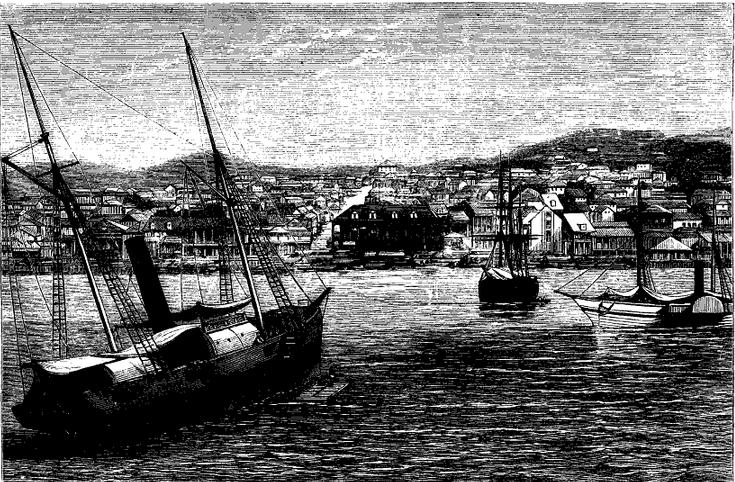
The harbor of Port-au-Prince
from
Santo Domingo, past and present, with a glance at Hayti.
Samuel Hazard (1834-1876)
New York: Harper Brothers, 1873
Page 43: This page seems to have been inserted here, breaking the continuity between 42 and 44.
disused salt works: Though the production of sea salt on Inagua had failed by 1896, the Morton Salt Company now provides Inagua's main industry, with a large solar salt operation. flamingoes: Wikipedia says of Inagua: "There is
a large bird sanctuary in the centre of the island with a
population of more than 80,000 West
Indian flamingoes and many other bird species...."

American flamingo
Image courtesy of Wikipedia
In Fields, Letters
of
Sarah
Orne Jewett, is a letter to Louisa Dresel dated 30
January 1896 from the Hermione, but apparently not
mailed until much later.
(TO MISS LOUISA DRESEL)
Steam Yacht Hermione, Kingston,
Jamaica, January 30, 1899.
Dear Loulie, -- I was so glad to get
your letter today, and so was Mrs. Fields. We are having a very
much better time as we go on, for A. F. is better and I, too,
and I find Jamaica a most enchantingly beautiful country. My
fellow travellers say that Ceylon is not a bit more beautiful.
We have been a week in Nassau, where I wrote you, and then came
down through the Bahamas, stopping only at Inagua, a strange
lonely island which I must tell you about some day, with its
wild marshes and a huge flock of flamingos, like all your best
red paints spilt on the shining mud. There had once been square
miles of salt works which were ruined by a tornado, and now the
flamingos blow about there like flames. Then we went to Hayti,
which was oh, so funny with its pomp of darkeys. Port au Prince
was quite an awful scene of thriftlessness and silly pretense --
but one or two little Haytian harbours and the high green coast
were most lovely. And then Jamaica, with all its new trees and
flowers, and its coolies, Loulie! with their bangles and turbans
and strange eyes. You would like Jamaica immensely.
Your news of the bicycle is very
entertaining. you will be cutting by a slow-footed friend any
day after I get back. I think it is so good for you, -- one
needs a serious reason for getting out of doors sometimes, and a
bicycle is a very serious reason indeed. The roads are so fine
here, winding and looping along the sides of the hills as they
do in Switzerland, -- fine English-made roads, -- and you look
up to the great mountains, and down to the blue sea.
the place: This insertion is in pencil. Though a number of changes in pencil appear in the manuscript after those parts that were revised into Fields's post-1898 document, I have decided not to mark them here. It seems unlikely that future scholars will be interested in this manuscript at that level of detail. Should that belief prove mistaken, a future scholar would need to return to the manuscript to examine the revisions.
Mr. Keitel of the banking house: G. Keitel
& Company, a banking firm established in Hamburg, Germany,
opened business in Port-au-Prince in 1867. The company
also was involved in import and export, transatlantic shipping,
and in Haitian railroads. Information about this
particular Mr. Keitel is welcome.
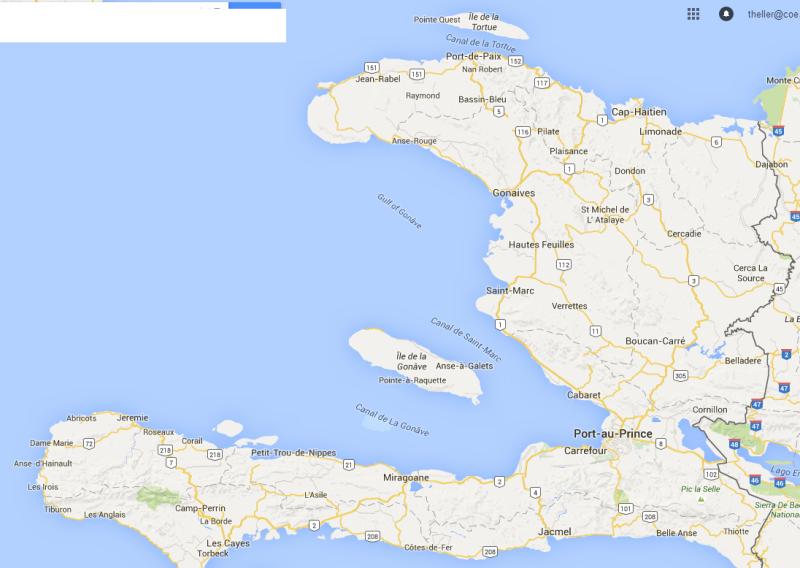
Map of Haiti
Courtesy of Google Maps
off the Cape Dame Marie: Cape
Dame Marie is at the west end of the southern peninsula of
Haiti. Straight line distance from Port-au-Prince to Cape
Dame Marie is about 110 miles. Fields several times has
difficulty keeping days and dates straight. January 27th
actually was a Monday.
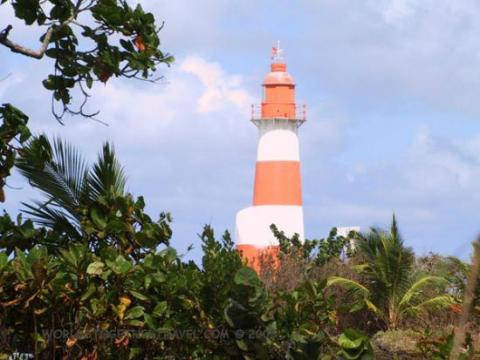
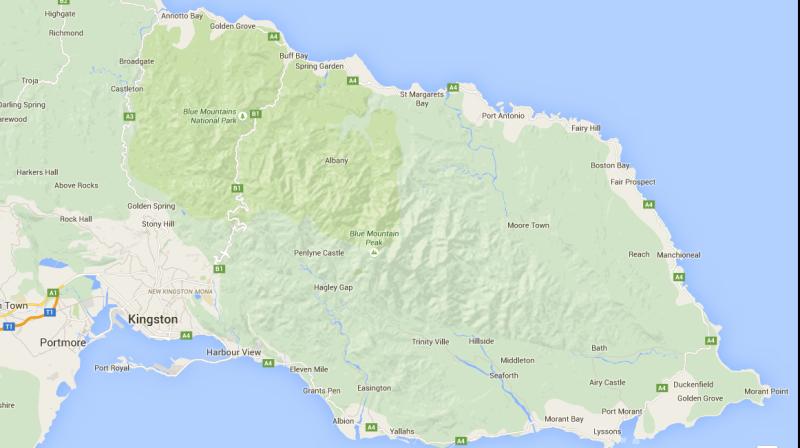
Eastern Jamaica
Map courtesy of Google Maps.
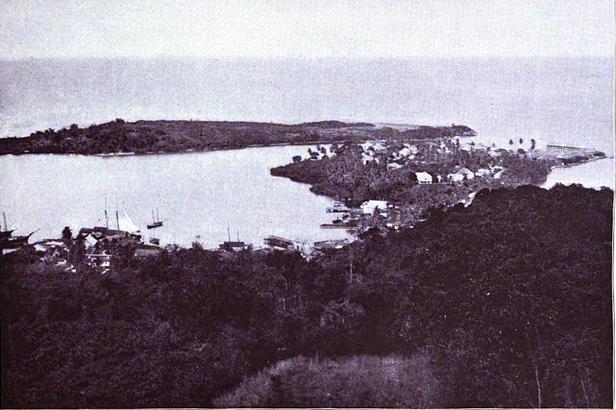
Harbor of Port Antonio
from Stark, p. 148
the Coolies: While Americans easily assume the
term "coolie" to apply to Chinese immigrant workers, Fields
specifies that the "coolies" she observes are East
Indians. There were Chinese immigrant workers in
Jamaica. Wikipedia offers a summary account of Chinese
Jamaicans: "The two earliest ships of Chinese
migrant workers to Jamaica arrived in 1854, the first directly
from China, the second composed of onward migrants from Panama;
they were contracted for plantation work. A further 200 would
arrive in the years up until 1870, mostly from other Caribbean
islands. Later, in 1884, a third wave of 680 Chinese migrants
would arrive...." The
National
Library
of
Jamaica provides a more detailed account of 19th-century
Chinese migrant workers.
Fields describes the imported workers of Port
Antonio as East Indian, which seems ambiguous, but her physical
descriptions of clothing seem to fit better the second
illustration below, showing workers likely to have come from
southern Asia.
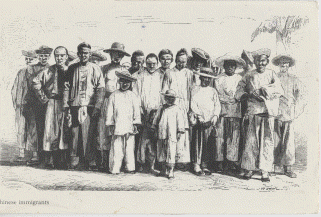
Chinese workers in Jamaica
Courtesy of The National Library of Jamaica
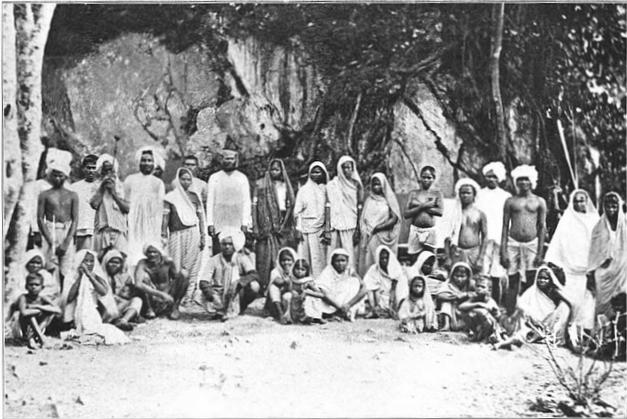
Foreign workers identified as "Newly Arrived Coolies"
Stark, p. 191.
Toussaint L'Ouverture: Wikipedia
says: François-Dominique Toussaint Louverture ...(20 May 1743 –
7 April 1803), .. nicknamed the "Napoléon Noir" (Black
Napoleon), was the leader of the Haitian Revolution. His
military genius and political acumen transformed an entire
society of slaves into the independent state of Haiti. The
success of the Haitian Revolution shook the institution of
slavery throughout the New World." Fields returns several
later times in her diary to her reflections about whether and
when Africans in the colonial islands will be capable of
self-rule, taking note of the seeming contrast between such
leading figures as Louverture and what she sees as the degraded
masses of the Black populations.
Bread-fruit Tree ... the Mango ... water-[laurel ?]
rhododendron: According to Wikipedia: "Breadfruit (Artocarpus
altilis) is a species of flowering tree in the mulberry
family (Moraceae) originating in the South Pacific and
that was eventually spread to the rest of Oceania. British and
French navigators introduced a few Polynesian seedless varieties
to Caribbean islands during the late 18th century and today it
is grown in some 90 countries throughout South and Southeast
Asia, the Pacific Ocean, the Caribbean, Central America and
Africa." It is valuable as a source of food as well as of
latex.
Wikipedia says that the Mango tree
originated in South Asia, but is now cultivated everywhere that
frost does not occur for its sweet red and golden fruit.
What Fields refers to apparently as a sort of
"water-laurel rhododendron" is quite uncertain. I have
found no other reference to such a plant. David
G.
Leach in the Journal of the American Rhododendron
Society (1957) indicates that tree Rhododendrons are not
native to Jamaica. He reports his surprise at finding on a
Jamaican mountain a scarlet blooming "R. arboreum, native
to the great arc of the Himalayas from Kashmir to Bhutan, and
with an outlying representative in Ceylon."
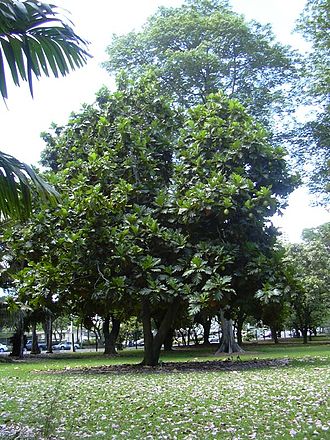 Bread fruit tree in Hawaii
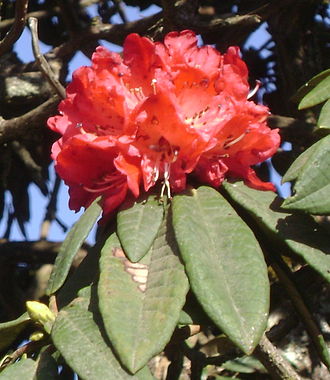 Blossom of Rhododendron arboreum From India 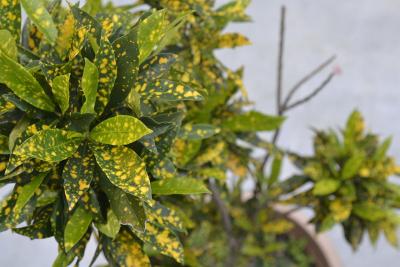 Aucuba japonica by Feen 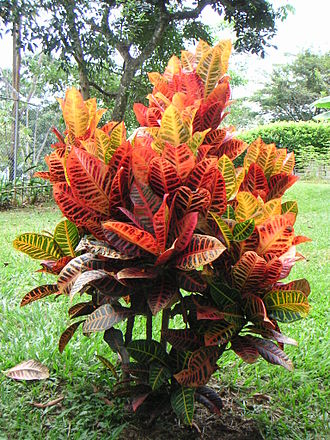 Garden Croton |
 Mango tree in Kerala, Inda 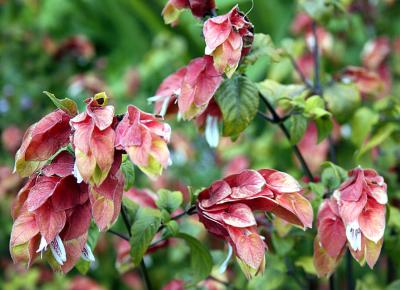 False Hops by Hedwig Storch  Coleus |
All images above courtesy of Wikipedia.
"false hops" a lovely shrub, ^with^ spotted leaves which
remind me of "the spotted Japonica" and Coleus (to the latter
family I think the plant belongs) but which are called Croton:
Unpacking
this
description
seems very complicated. Wikipedia's description of Justicia
brandegeeana, commonly called "false hops," seems to
fit Fields's image. Exactly how she relates the other
plants except by similar appearance seems obscure.
Wikipedia says: "Aucuba
japonica, commonly called spotted laurel, Japanese
laurel, Japanese aucuba or gold dust plant (U.S.), is a shrub (1
- 5 m, 3.3 - 16.4 ft) native to rich forest soils of moist
valleys, thickets, by streams and near shaded moist rocks in
China, Korea, and Japan. This is the species of Aucuba commonly
seen in gardens -- often in variegated form."
"Plectranthus
scutellarioides (coleus) is a species of flowering
plant in the family Lamiaceae, native to south east Asia
and Malaysia. Growing to 60–75 cm (24–30 in) tall and wide, it
is a bushy, woody-based evergreen perennial, widely grown for
its highly decorative variegated leaves"
If she is using "Croton" as the name of a
family of plants, it is not clear that any of the other three
plants belongs to this family. On the other hand garden
croton, Codiaeum
variegatum, does resemble the other plants, with its
colorful leaves.
Stark's Jamaica Guide: Containing a Description of Everything Relating to Jamaica (1902), p. 146, by James Henry Stark, notes that Mr. J. A. Jones was an assistant manager of the United Fruit Company, formed in 1899, when Boston Fruit merged with another company. The Manual of Statistics: Stock Exchange Hand-book (1905), Volumes 26-30; Volume 38, Charles M. Goodsell, Henry E. Wallace, p. 744, reports on the United Fruit Company, listing James A. Jones as one of the directors. This description is especially useful in indicating the power of the company, which in 1904 had massive assets, $15 million in issued stock and annual net earnings in excess of $2 million.
the Consul, Mr. Davis, ... Boston beans: The American Consul at Port Antonio in 1896 has not been identified. Assistance is welcome.
Presumably, Mr. Davis sends the Hermione some Boston baked beans, or perhaps dried beans to be used in making this dish.
pictures in ^the back of^ Mitchell's Geography come true:
Wikipedia
says:
"Samuel
Augustus Mitchell (1790-1868) was an American
geographer.... He became involved in geography after teaching
and realizing that there were so many poor quality geographical
resources available to teachers." Which of Mitchell's
several geographies Aldrich refers to is not clear. Those
currently available as Google Books do not collect illustrations
"at the back," but several contain drawings related to the West
Indies. See for example: Mitchell's
School Geography (1860), p. 188.
tree-bamboos waving their gemlike plumes against the sky:
Probably,
Fields
was
viewing Bambusa vulgaris, which grows on the Caribbean
islands.
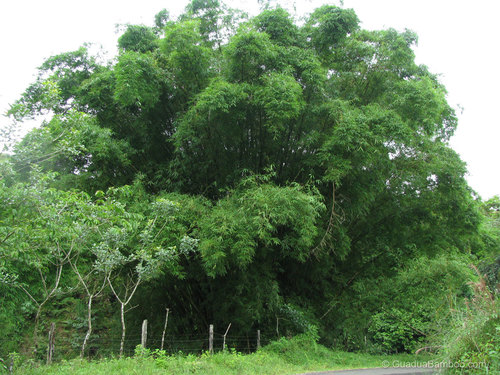
Tree bamboo
Image courtesy of Guadua
Bamboo, Bamboo Species
Rio Grande: Stark's Guide to Jamaica says the Rio
Grande is the second largest river in Jamaica, and it flows
through the Golden Vale, a rich banana growing area owned by the
Boston Fruit Company (pp. 149-50). On the map above, it is
seen emptying into St. Margaret's Bay, west of Port Antonio.
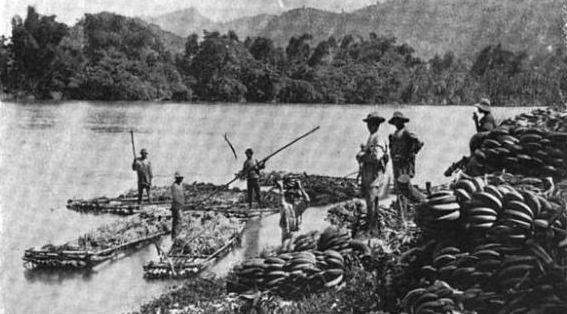
"A New England Farmer in Jamaica." New England Magazine, Dec. 1894.
Courtesy of Wikipedia
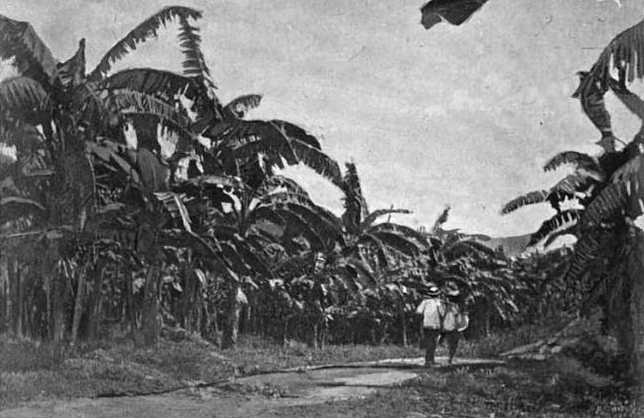
Humphrey. "Where Bananas Grow." Popular Science Monthly, Feb. 1894.
Courtesy of Wikipedia
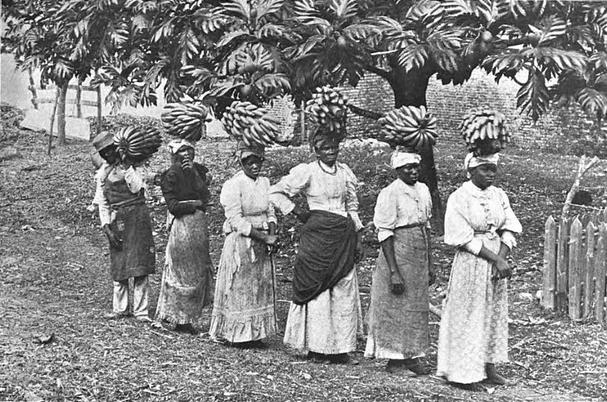
Women carrying bananas at Port Morant
From Stark, p. 98
[ Tuesday 28 January ]
January 28th ^Rainy^ everywhere ^Today^ we
steamed away from Port Antonio to Port Morant *-- four hours
only ^in the afternoon^ -- but the sea was pretty rough the wind
high and warm and I kept as still as possible but nobody was
really sick. We came into harbor just at sunset, a quiet
beautiful bay, with lovely mountain sides clothed with
cocoa-palms and bamboo. What a lovely sunset it was! but
short as sunsets must be at in winter on Jamaica; by
half past six, if the moon were not in the sky it would be
dark. But now it is never dark with us; save [unless /
when ?] it was raining at Port Antonio. We have now
left the clouds on the northern side of the island, behind the
mountains where they lie troubled with soft pink by the
setting sun and the moon [coming ?]
Page 52
up above them. The colors are all soft and pallid but
tender --; This is winter in the tropics!
Note
from Port Antonio to Port Morant: By sea,
the distance between these ports in Jamaica would be something
in excess of 70 miles.
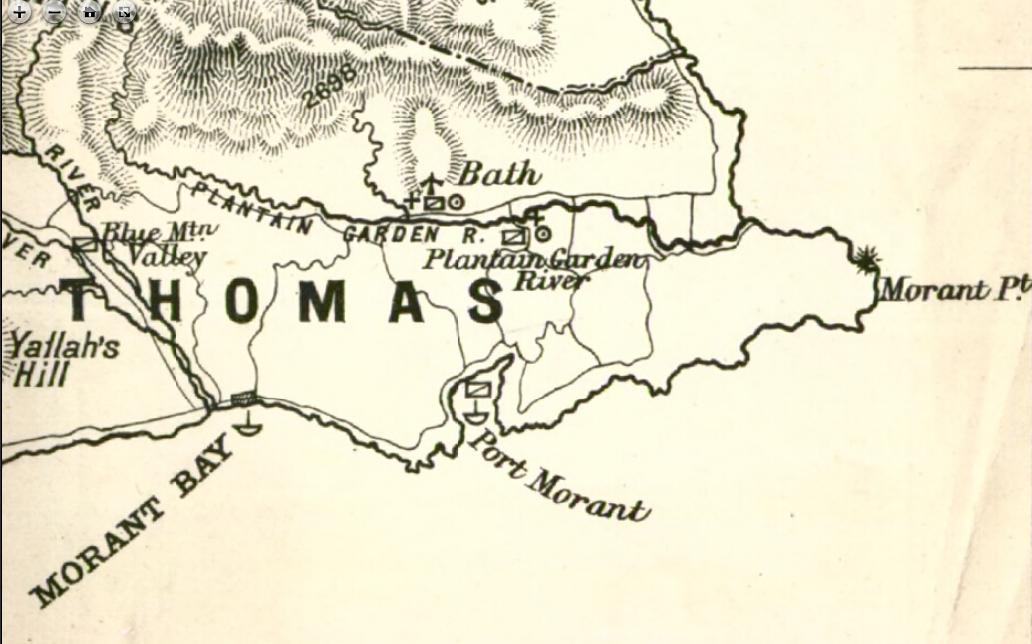
From 1896 Map Jamaica, eastern portion
Courtesy of Digital Library of the Caribbean
Wednesday 29th at Port Morant.* [deleted word]
^A^ place [deleted word] to remind [deleted word]
^one^ of [deleted letters] the Garden of Eden.*
Horses were waiting for us early by the kindness again of
Captain Baker of the Fruit Company. We drove nearly all
day taking luncheon at Miss Duffy's lodgings in a little
hamlet called Bath.* The valleys through which we travelled,
over smooth roads were thickly inhabited by colored people and
coolies -- The latter deeply interesting and picturesque as
usual. [Deleted word] The whole way seemed to be
decorated by the hand of taste! How the red Hibiscus
shown! and the dark [Deleted word] !
How
splendid
the star apple tree with its bronze foliage! But the
splendor soon outshone the power of taste! We
suddenly saw a tree ^as large as a [Deleted word] fine
oak^ making a glory in the sky with a sea of red -- almost
vermilion blossoms. Later we found it is called Spathodia.
Returning
to
our
boat we steamed on through a smooth sea to Kingston. It
was beautiful sailing the whole distance. At sundown we
anchored off Port Royal.
Notes
Port Morant: On the southeastern
coast of Jamaica, Port Morant has a history as a main port in
the banana and rum trades.
the Garden of Eden: In Genesis, the original home of
Adam and Eve, is a paradise that meets all human material needs.
Miss Duffy's lodgings
in
a
little hamlet called Bath:
Stark reports that Bath was at one time the main spa in
Jamaica, with its Bath of St. Thomas the Apostle.
Stark's description of the road from Port Morant closely
parallels that of Fields (pp. 99-100).
In A
Glimpse of the Tropics; Or, Four Months Cruising in the West
Indies (1900), Edward Aubrey Hastings Jay describes
staying
at
Miss Duffy's:
From Morant Bay we drove by the coast road to Fisherman's Bay, and then turned inland, following the course of a lovely valley to Bath. This last bit of road is indeed scarcely rivalled in Jamaica for its exquisite beauty. We followed the course of a deep ravine, the vegetation becoming richer at every turn of the road, masses and masses of feathery bamboos covering the mountain sides, and ferns, mosses, and creepers growing in a wild tangle along the banks.
We drove at length into the little sylvan town of Bath, nestling in a garden of strange tropical trees, amongst which were specimens imported from every quarter of the globe. Miss Duffy's lodging, with its picturesque balcony overlooking this vision of beauty, and its shady little yard overshadowed by the spreading leaves of a magnificent bread-fruit tree, tempted us to spend the rest of our days in Bath. We found that the inside of her charming little house in no way belied its cosy appearance.
Tired and stiff after driving nearly forty miles cramped up in a buggy, we were glad to stretch our limbs on the shady balcony. Close to the wall was a calabash tree, with its huge green fruit hanging like cannon-balls from the branches.... In a meadow opposite were big forest trees with gorgeous blossoms, some red and some orange. The names of all the varieties here it would be impossible for any one but an expert to grasp, still less to remember. Among the most striking was the Otaheite Apple, a tall, majestic tree, with luxuriant foliage and bright scarlet blossoms. Another was the Guango (Pithecolobium saman), a near relation of the wild tamarind. This tree is often as much as six feet in diameter, with spreading branches, and covered with blossoms of a mauve tint and delicate texture. There were also several specimens of the akce, naturalised from West Africa -- a bushy tree with leaves like those of an ash, and bearing on its branches a beautiful scarlet fruit, which splits open when ripe, and displays a row of black seeds enclosed in a white pulp. The akee has a delicious scent and flavour, and is not unlike a nectarine. Here, too, we saw a gigantic silk-cotton tree, with its trunk covered to a height of about forty or fifty feet with the aerial roots of a wild fig, which was slowly crushing the life out of it.
Miss Duffy gave us an excellent little dinner, well cooked and nicely served, and we strolled out afterwards to explore and to enjoy the cool night air. (249-51)
For
another
contemporary
description of Lucretia Duffy's lodgings and the baths, see Side
Trips in Jamaica (1900), by Mary F. Bradford
(p. 38). Bradford also notes the good Jamaican cooking
at Duffy's.
star apple tree: Wikipedia says that Chrysophyllum
cainito, also known as Star Apple, "is a tropical
tree of the family Sapotaceae. It is native to the
Greater Antilles and the West Indies. It has spread to the
lowlands of Central America and is now is grown throughout the
tropics, including Southeast Asia. It grows rapidly and
reaches 20 m in height."
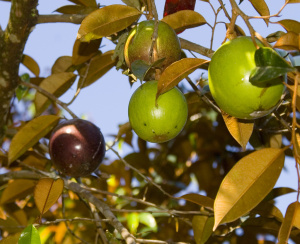 |
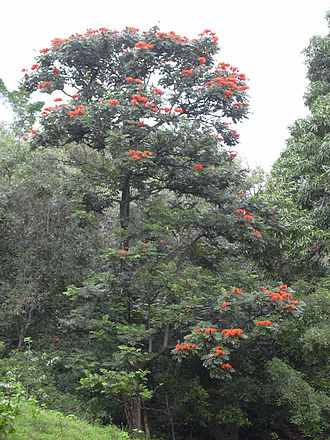 Spathodea
Image courtesy of Wikipedia |
red -- almost vermilion blossoms. Later we found it is
called Spathodia:
Spathodea,
says Wikipedia, is: "The ... Spathodea campanulata
... commonly known as the fountain tree, African tulip
tree, pichkari or Nandi flame. The tree grows between
7–25 m (23–82 ft) tall and is native to tropical dry
forests of Africa. It has been nominated as among 100 of
the 'World's Worst' invaders."
Kingston… Port Royal:
Port
Morant
to Kingston
is about 70 miles. As the map below indicates, Port
Royal is at the entrance to Kingston Harbor.

Google Map of Kingston, Jamaica
[ Thursday 30 January ]
Thursday 30th We awakened as if we were still continuing the dream of beauty in which we floated the night before, when the moon rose full at sunset and there was no darkness.
English men of war* are in Kingston harbor and
their 'music' filled the evening air. We lay on deck and
drank in the lovely scene as we rested. Thursday morning
the moon was still shining brilliantly when we arose because
the sun sets early and rises late [one and one half lines
and insertions deleted. Readable deleted words seem to
be: we are cheating ^us^ with the idea that it is
summer.] The hours remain as they are at home, but the
heat is that of summer. The cook* passed up ^the
gangway^ today with a basket of fresh fish which he
stopped to show us. Bonita, hard and yellow -- [Deleted
word] red snapper* and little [lilac ?] bodies
veined with yellow. They are brilliant and beautiful as
the flowers. This city of Kingston was
white and dusty and hot; we were amused as usual by the
colored people but it was too scorching to stay long from the
boat especially as there is little to attract one in the town
itself. The five thousand white people ^persons^
who live here with about 50,000 ^of the^ colored people, have
made homes for themselves on the mountain sides above the town
and some of these places we hope to see.*
It is lovely to watch the light from
^looking from our boat in^ the harbor glowing upon the
mountain sides. High up we can just discover like a rift
[intended drift ?] of
Page 54
Notes

Collection of the Massachusetts Historical Society
English men of war: In The Royal Navy: a History from the Earliest Times to the Death of Queen Victoria (1903), the authors include an image of the "Spithead review 1897 Chevalier de Martino" (p. 400). This photo of a naval review celebrating Queen Victoria's Diamond Jubilee should give some impression of how British warships may have appeared in the Kingston harbor in 1896. It is not clear that Fields means the term "men of war" technically; she seems rather to apply it to navy vessels generally.
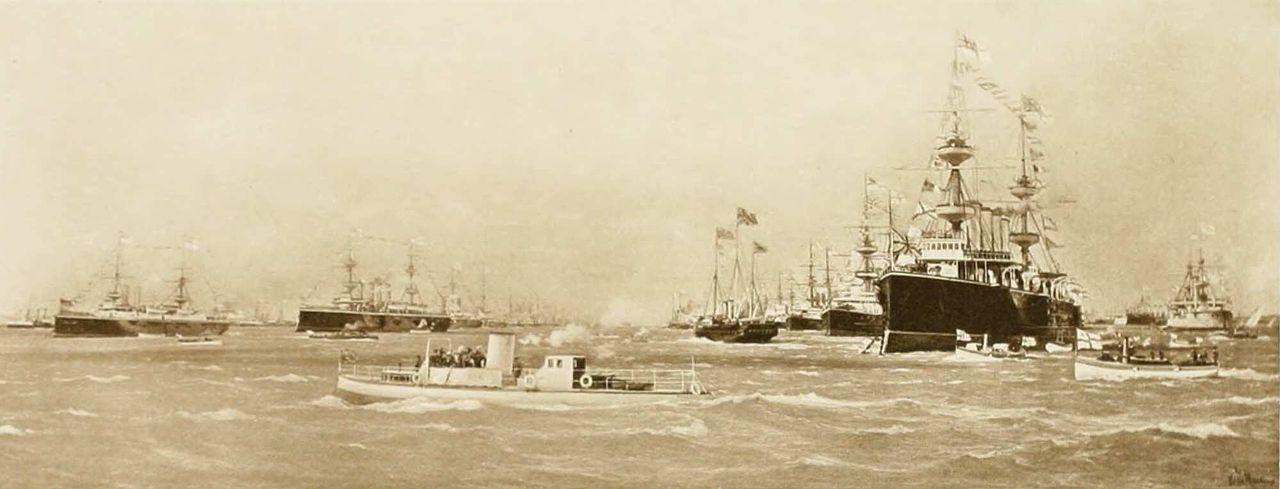
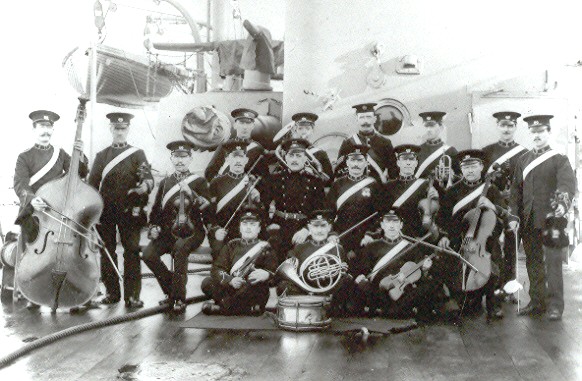
Image of a Royal Marine Band on the HMS
Commonwealth (1909)
from Henry Eaves
which offers this citation: RM Museum in Southsea, UK.
the cook: Information about the crew on this voyage would be welcome.
Bonita … red snapper: Wikipedia
says: "The Atlantic
bonito, Sarda sarda, is a large
mackerel-like fish of the family Scombridae. It is
common in shallow waters of the Atlantic Ocean, the
Mediterranean Sea, and the Black Sea, where it is an
important commercial and game fish." "The northern red
snapper, Lutjanus campechanus, is a species
of snapper native to the western Atlantic Ocean including
the Gulf of Mexico, where it inhabits environments
associated with reefs. This species is commercially
important and is also sought-after as a game fish.
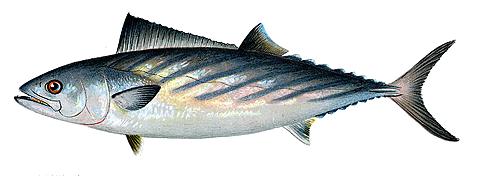 "Sarda sarda" by Sherman Foote
Denton
'State of New York Annual Report of the Commissioners of Fisheries, Game, and Forests (1895-1906).' Courtesy of Wikipedia. |
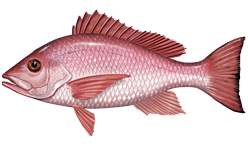 Red Snapper
Image courtesy of Wikipedia A mature Bonito may be 30 inches; a Red Snapper,. 15 inches. |
mountain sides above the town:
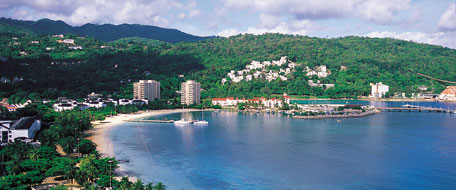
Kingston view, showing northeastern mountains in
background.
Courtesy of Hotels
of Kingston
Newcastle: In his description of the Newcastle
area in Chapter 9 (pp. 77-80), Stark indicates that the
camp was northeast of Kingston, beyond Gordon Town,
several miles up the Hope River, which flows into the sea
at Harbor View (see Kingston map above).
The original of this diary is in the collection of the Massachusetts Historical Society. My copy is from a microfilm, available courtesy of the University of Kansas Libraries, Lawrence, Kansas: Annie Adams Fields Papers 1852-1912. Folio PS 1669.F5 Z462 1986, Reel 2.
| Works of Annie Fields |
